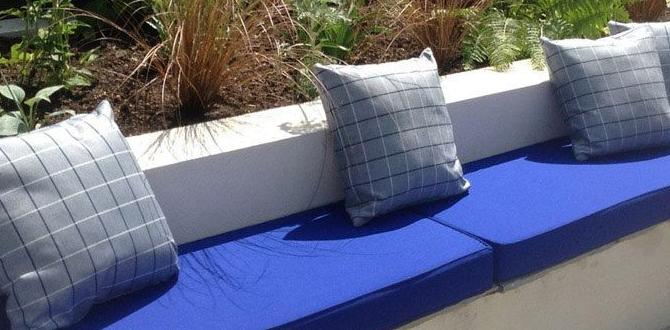Quick Summary:
Caring for a cat palm indoors is easy! Provide bright, indirect light, water when the top inch of soil feels dry, use well-draining soil, and maintain moderate humidity and room temperatures. Occasional feeding and repotting will keep your Chamaedorea erumpens thriving.
Welcome to EcoPatchy! Are you looking to bring a touch of lush, tropical greenery into your home without all the fuss? The cat palm, scientifically known as Chamaedorea erumpens, is a fantastic choice for beginners and seasoned plant lovers alike. Often called the ” Parlor Palm,” this graceful plant is renowned for its elegance and ease of care, making it a perfect fit for various indoor environments. We all want our houseplants to flourish, but sometimes, figuring out exactly what a plant needs can feel like a puzzle. Don’t worry! This guide will break down everything you need to know to keep your cat palm happy, healthy, and vibrantly green. Get ready to transform your living space into a mini indoor oasis.
Why Choose a Cat Palm for Your Home?
The cat palm is a popular choice for indoor gardening for many wonderful reasons. It’s a relatively small, clumping palm that adds a sophisticated, tropical flair to any room. Unlike some other palm varieties that can grow quite large and demanding, the cat palm stays manageable, making it ideal for smaller spaces like apartments, offices, or even a cozy corner in your living room. Its feathery, arching fronds bring a sense of calm and natural beauty, instantly enhancing your décor. Plus, it’s quite forgiving, which is always a big plus when you’re just starting your plant journey or live a busy life. Its natural air-purifying qualities are an added bonus, contributing to a healthier indoor environment.
Beyond aesthetics, the cat palm is known for its resilience. It can tolerate a range of indoor conditions, though it appreciates specific care to truly thrive. Its ability to adapt makes it a more forgiving plant than many other delicate ornamentals. This means fewer worries about accidental overwatering or periods of less-than-ideal light. It’s the kind of plant that grows with you, offering a rewarding experience for minimal effort.
Understanding Your Cat Palm: What it Needs
To successfully care for a cat palm indoors, it’s essential to understand its native habitat and what conditions it naturally prefers. Cat palms are native to the rainforests of southern Mexico and Central America. In these lush, humid environments, they grow in the understory, meaning they are accustomed to dappled sunlight filtering through a dense canopy of larger trees. This crucial piece of information guides us on the most important aspects of their indoor care: light, water, and humidity.
Mimicking their natural environment as closely as possible indoors is the key to a happy and healthy cat palm. This means providing the right kind of light (not direct sun!), ensuring consistent moisture without waterlogging the roots, and creating a humid atmosphere. We’ll dive deep into each of these elements to make sure you have all the information you need to nurture your leafy companion.
Essential Cat Palm Care Steps
Caring for your cat palm indoors is wonderfully straightforward once you understand its basic needs. Here’s a breakdown of the essential steps to ensure your plant thrives:
1. Light Requirements: Finding the Perfect Spot
Cat palms, or Chamaedorea erumpens, are understory plants in their native rainforest habitat. This means they are adapted to receiving filtered, indirect light, not harsh, direct sunlight which can scorch their delicate fronds. Too little light can result in leggy growth and pale leaves, while too much direct sun will cause browning and damage.
- Ideal Light: Bright, indirect light is best. Think of a spot near an east-facing window or a few feet away from a south or west-facing window where the sun’s rays are softened by curtains or other obstructions.
- Signs of Too Much Light: Yellowing leaves, brown tips, or scorched patches on the foliage indicate the light is too intense.
- Signs of Too Little Light: Slow growth, small new leaves, and a generally sparse appearance can mean it needs a brighter (but still indirect) location.
- Low Light Tolerance: While they prefer bright, indirect light, cat palms can tolerate lower light conditions better than many other palms. However, growth will be significantly slower, and they may not reach their full potential.
2. Watering: The Key to Happy Roots
Proper watering is perhaps the most critical aspect of cat palm care. These palms prefer consistently moist soil but absolutely hate sitting in waterlogged conditions, which can quickly lead to root rot – a common killer of houseplants. It’s much better to underwater slightly than to overwater.
- How to Check Soil Moisture: Stick your finger about an inch or two into the soil. If it feels dry to the touch, it’s time to water. If it still feels moist, wait a few more days and check again.
- Watering Technique: Water thoroughly until water drains from the bottom of the pot. Discard any excess water that collects in the saucer after about 30 minutes. This ensures the entire root ball gets hydrated without the plant’s roots sitting in standing water.
- Watering Frequency: This will vary depending on your home environment (temperature, humidity, sunlight), the size of your plant, and the type of pot. In warmer months with more light, you might water once a week. In cooler, darker months, you might only need to water every two weeks or even less.
- Water Quality: Cat palms can be sensitive to chemicals found in tap water, such as fluoride and chlorine. If you notice brown tips or edges on the leaves, try using filtered water, distilled water, or rainwater. Letting tap water sit out overnight can also help some of the chlorine evaporate.
3. Soil: Providing a Well-Draining Foundation
The right soil mix is vital for preventing root rot and ensuring your cat palm has access to the nutrients it needs. A well-draining potting mix is essential, mimicking the sandy soils found in its native tropical environment.
- Recommended Mix: Use a good quality, peat-based potting mix specifically formulated for houseplants. You can significantly improve drainage by adding amendments like perlite or coarse sand. A good ratio might be 2 parts potting soil to 1 part perlite or orchid bark for added aeration.
- Avoidance: Do not use garden soil, as it compacts too easily in pots and drastically reduces drainage.
- Repotting Needs: Cat palms generally prefer to be a bit root-bound and don’t need frequent repotting. Repot only when you see roots emerging from the drainage holes or the plant seems to be drying out much faster than usual. This is typically every 2-3 years.
- Choosing a Pot: Ensure the pot has adequate drainage holes. Terracotta pots can be beneficial as they allow the soil to dry out more quickly, which can help prevent overwatering, but they may require more frequent watering. Plastic or glazed pots retain moisture longer.
4. Temperature and Humidity: Creating a Tropical Vibe
Cat palms are tropical plants and thrive in conditions that mimic their native rainforest climate. This means they appreciate warmth and, especially, humidity.
- Temperature: They prefer average to warm room temperatures, ideally between 65°F and 80°F (18°C – 27°C). They can tolerate slightly cooler temperatures down to 50°F (-10°C) for short periods but should not be exposed to frost. Avoid placing them near drafty windows, heating vents, or air conditioning units, as sudden temperature fluctuations can stress the plant.
- Humidity: This is where many indoor environments fall short for tropical plants. Cat palms love high humidity, and dry air can lead to crispy brown leaf tips and edges.
- Increasing Humidity:
- Misting: Lightly misting the leaves with water a few times a week can help, but it’s a temporary fix.
- Pebble Tray: Place the pot on a tray filled with pebbles and water. As the water evaporates, it increases humidity around the plant. Ensure the bottom of the pot doesn’t sit directly in the water.
- Grouping Plants: Placing your cat palm with other plants can create a microclimate with higher humidity.
- Humidifier: The most effective way to boost humidity, especially in dry climates or during winter, is to use a small room humidifier near your plant.
5. Fertilizing: Nourishing Your Plant
While cat palms are not heavy feeders, they benefit from occasional fertilization, especially during their active growing season. Over-fertilizing can be more harmful than not fertilizing at all.
- When to Fertilize: Feed your cat palm during the spring and summer months when plant growth is most active. Avoid fertilizing in the fall and winter when growth slows down.
- Type of Fertilizer: Use a balanced, water-soluble liquid fertilizer diluted to half strength. A fertilizer formulated for houseplants or palms is ideal. Look for N-P-K ratios like 10-10-10 or similar. For example, using a palm-specific fertilizer like this guide from Wilson Bros Gardens suggests specific approaches for palm fertilization.
- Frequency: Fertilize once a month during the growing season.
- Signs of Over-Fertilizing: Watch for brown leaf tips or edges, wilting, or unusual leaf discoloration, which can indicate too much fertilizer. If you suspect over-fertilization, flush the soil with plenty of plain water to remove excess salts.
6. Pruning and Cleaning: Keeping it Tidy
Pruning your cat palm is primarily about removing yellow or dead foliage to maintain its appearance and direct energy to new growth. Palms do not typically regrow cut stems or leaves.
- What to Prune: Use clean, sharp scissors or pruning shears to cut off any leaves that have turned completely yellow or brown. You can also trim off brown tips or edges. Cut leaves back to the base of the plant if they are entirely dead.
- Don’t Over-Prune: Avoid removing green, healthy leaves, as this can weaken the plant.
- Cleaning the Leaves: Dust can accumulate on the broad leaves, blocking sunlight and potentially harboring pests. Gently wipe down the leaves with a damp cloth or sponge every few weeks. You can also give the plant a gentle shower in the bathtub or sink periodically to wash away dust and refresh it. Ensure the plant dries off before returning it to its spot.
Common Cat Palm Problems and Solutions
Even the easiest plants can encounter a few issues. Here are some common problems you might face with your cat palm and how to solve them:
| Problem | Cause | Solution |
|---|---|---|
| Brown Leaf Tips/Edges | Low humidity, inconsistent watering, or mineral buildup from tap water. | Increase humidity (misting, pebble tray, humidifier). Ensure consistent watering, letting the top inch of soil dry out. Use filtered or distilled water. Flush soil if mineral buildup is suspected. |
| Yellowing Leaves | Overwatering (most common), underwatering, or sometimes lack of light. | Check soil moisture before watering. If soil is constantly wet, reduce watering frequency and ensure good drainage. If soil is dry, water more thoroughly. If light is very low, move to a brighter spot. |
| Wilting Leaves | Both overwatering and underwatering can cause wilting. Also, sudden temperature changes. | Check soil moisture. If dry, water thoroughly. If wet, allow soil to dry out and check for root rot. Protect from drafts and temperature extremes. |
| Pests (Spider Mites, Mealybugs) | Dry air, stress, or introduction from other plants. | Isolate the plant. Wipe leaves with a damp cloth to remove pests. For heavier infestations, use insecticidal soap or neem oil. Increase humidity to deter spider mites. |
| Slow Growth or Small Leaves | Insufficient light or lack of nutrients. | Move the plant to a location with brighter, indirect light. Fertilize during the growing season (spring/summer) with a balanced liquid fertilizer diluted by half. |
Repotting Your Cat Palm
Cat palms are not overly demanding when it comes to repotting. They actually prefer to be slightly root-bound, meaning they are comfortable with their roots filling most of the pot. This is a good indicator that they are content.
- When to Repot: Look for signs that your cat palm is outgrowing its pot. This usually happens every 2 to 3 years. Common signs include roots growing out of the drainage holes, water draining through the pot very quickly due to compacted soil, or the plant drying out much faster than it used to.
- Choosing a New Pot: Select a pot that is only 1-2 inches larger in diameter than the current one. Make sure it has drainage holes.
- The Repotting Process:
- Gently remove the plant from its current pot. If it’s stuck, you might need to run a knife around the edge.
- Inspect the roots. If they are tightly bound, you can gently loosen them with your fingers or a clean tool. If you see any rotten or mushy roots (dark brown or black and soft), trim them away with clean shears.
- Place a layer of fresh, well-draining potting mix at the bottom of the new pot.
- Center the cat palm in the new pot, ensuring the top of the root ball is about an inch below the rim.
- Fill in the sides with more potting mix, gently firming it down.
- Water the plant thoroughly to help settle the soil.
- Post-Repotting Care: Place your freshly repotted cat palm in its usual spot and avoid fertilizing for a few weeks to allow it to adjust.
Propagation: Sharing Your Green Thumb
Cat palms are typically propagated by division. This means gently separating the clumps of stems that naturally grow from the base of the parent plant. It’s a great way to create more plants or to rejuvenate an older, overcrowded specimen.
- When to Propagate: The best time to divide your cat palm is when you are repotting it, usually every 2-3 years.
- The Division Process:
- Carefully remove the entire plant from its pot.
- Gently shake off excess soil to expose the root structure.
- Examine the base of the plant. You’ll see where new shoots are growing from the main clump.
- Using a clean, sharp knife or trowel, carefully cut through the root ball to separate a division. Aim for a section that has several healthy stems and a good portion of the root system attached.
- You can repot the parent plant as usual and then plant the new division in its own pot with fresh, well-draining potting mix.
- Water both the parent plant and the new division thoroughly after repotting.
- Care for New Divisions: Treat new divisions like young plants. Keep them in bright, indirect light and maintain consistent moisture. They may take a little while to establish and show new growth.
Cat Palm Benefits: More Than Just Pretty
Beyond their striking appearance, cat palms offer several benefits that make them a welcome addition to any indoor space.
- Air Purification: Like many houseplants, cat palms can help filter indoor air pollutants. While the scientific data on how much air they purify compared to other plants can vary, studies by NASA have shown that plants can remove volatile organic compounds (VOCs) like formaldehyde and benzene from the air.
- Aesthetic Appeal: Their elegant, feathery fronds add a tropical, calming, and sophisticated ambiance to any room. They can soften hard architectural lines and bring life to dull corners.
- Stress Reduction: The act of caring for plants and having greenery around is widely believed to reduce stress and improve mood. The presence of plants can create a more tranquil and inviting environment.
- Improved Indoor Environment: They contribute to a more pleasant and potentially healthier indoor atmosphere, making your living or working space more enjoyable.
Frequently Asked Questions About Cat Palm Care
Q1: How often should I water my cat palm?
Water your cat palm when the top inch of soil feels dry. This typically means watering about once a week during the growing season (spring/summer) and less frequently in cooler, darker months (fall/winter). Always check the soil moisture with your finger before watering, and ensure excess water drains away.
Q2: Can my cat palm tolerate low light conditions?
Yes, cat palms are quite tolerant of lower light conditions compared to many other houseplants. However, they will grow best and appear lusest in bright, indirect light. In very low light, growth will be slow, and the plant may become leggy





